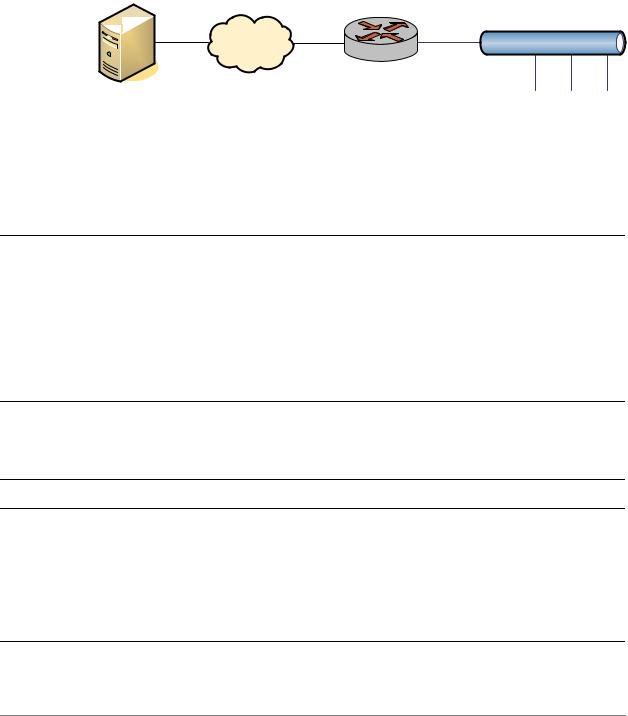
- •Table of Contents
- •Quick Reference to Commands
- •Quick List of Examples
- •Preface
- •Intended Audience
- •Organization of This Guide
- •Document Conventions
- •Vyatta Publications
- •Chapter 1: SSH
- •SSH Configuration
- •SSH Commands
- •service ssh
- •service ssh port <port>
- •Chapter 2: Telnet
- •Telnet Configuration
- •Telnet Commands
- •service telnet
- •service telnet port <port>
- •telnet <address>
- •Chapter 3: Web GUI Access (https)
- •Web GUI Access Configuration
- •Web GUI Access Commands
- •service https
- •Chapter 4: DHCP
- •DHCP Overview
- •DHCP Configuration
- •Enabling the DHCP Server
- •Configuring DHCP Address Pools
- •Creating a Static Mapping
- •Setting up DHCP Servers for Failover
- •Setting up DHCP Relay
- •Setting Additional DHCP Configuration Parameters
- •DHCP Commands
- •clear dhcp lease ip <ipv4>
- •clear dhcp leases
- •release dhcp interface <interface>
- •renew dhcp interface <interface>
- •show dhcp client leases
- •show dhcp leases
- •show dhcp statistics
- •Chapter 5: DHCPv6
- •DHCPv6 Overview
- •DHCPv6 Configuration
- •Enabling the DHCPv6 Server
- •Configuring DHCPv6 Address Pools
- •Creating a Static Mapping
- •Setting up DHCPv6 Relay
- •Setting up DHCPv6 Client
- •DHCPv6 Commands
- •release dhcpv6 interface <interface>
- •renew dhcpv6 interface <interface>
- •restart dhcpv6 relay-agent
- •restart dhcpv6 server
- •show dhcpv6 client leases
- •show dhcpv6 relay-agent status
- •show dhcpv6 server leases
- •show dhcpv6 server status
- •Chapter 6: DNS
- •DNS Configuration
- •DNS Overview
- •System DNS
- •Dynamic DNS
- •DNS Forwarding
- •DNS Configuration Examples
- •Configuring Access to a Name Server
- •Configuring Dynamic DNS
- •Configuring DNS Forwarding
- •Statically Configured Entries and DNS Forwarding
- •DNS Commands
- •clear dns forwarding all
- •clear dns forwarding cache
- •service dns dynamic interface <interface>
- •service dns dynamic interface <interface> service <service>
- •service dns dynamic interface <interface> service <service> server <addr>
- •service dns forwarding dhcp <interface>
- •service dns forwarding system
- •show dns dynamic status
- •show dns forwarding nameservers
- •show dns forwarding statistics
- •update dns dynamic interface <interface>
- •Chapter 7: Web Caching
- •Web Caching Configuration
- •Web Caching Overview
- •Web Caching Configuration Example
- •Configuring Web Caching
- •Web Caching Commands
- •restart webproxy
- •show webproxy log
- •Chapter 8: LLDP
- •LLDP Configuration
- •LLDP Overview
- •Configuring LLDP
- •Displaying LLDP Information
- •LLDP Commands
- •service lldp
- •show lldp neighbors
- •Glossary of Acronyms

Chapter 4: DHCP |
DHCP Configuration 40 |
|
|
|
|
Example 4 5 Setting up DHCP failover on R2
Specify the name of the failover |
vyatta@R2# set service dhcp server shared network name DHCP1 |
group. |
subnet 192.168.42.0/24 failover name FAILOVER |
|
|
Commit the change |
vyatta@R2# commit |
|
|
Show the configuration. |
vyatta@R2# show service dhcp server shared network name DHCP1 |
|
shared network name DHCP1 { |
|
subnet 192.168.42.0/24 { |
|
default router 192.168.42.254 |
|
dns server 192.168.42.253 |
|
failover { |
|
local address 192.168.42.2 |
|
name FAILOVER |
|
peer address 192.168.42.1 |
|
status secondary |
|
} |
|
start 192.168.42.100 { |
|
stop 192.168.42.199 |
|
} |
|
} |
|
} |
|
|
Setting up DHCP Relay
Configure DHCP relay if you want the Vyatta system to forward DHCP requests to another DHCP server.
Every interface involved in the DHCP relay must be configured and must be broadcast-capable. So, for example, if requests are coming in on interface eth0 and the DHCP server specified in the configuration is reached through interface eth1, both eth0 and eth1 must be configured for DHCP.
Example 4-6 does the following:
•Configures both eth0 and eth1 for DHCP. The router is expected to receive client requests for the DHCP server through interface eth0. It will forward client-to-server DHCP messages to the DHCP server at 172.16.1.52 out through interface eth1.
•Enables relay options. This directs the system to add the Relay Agent Information option (option 82) to the DHCP message before forwarding, as specified by RFC 3046.
•Re-forwarding of DHCP messages will not be permitted by this system. If a packet is received that already contains relay information, the packet is discarded.
Services |
R6.3 v01 |
Vyatta |

Chapter 4: DHCP |
DHCP Configuration 41 |
|
|
|
|
•Other relay option parameters are left at default values. This means that the router will use port 67 for DHCP messaging, will allow a maximum DHCP packet size of at most 576 bytes, and will have a maximum hop count of 10 hops.
Figure 4-3 shows the sample DHCP relay configuration.
Figure 4 3 DHCP relay configuration
R1
|
eth1 |
eth0 |
|
DHCP Server |
DHCP Relay |
DHCP clients |
|
172.16.1.52 |
|||
|
|
To configure DHCP relay, perform the following steps in configuration mode:
Example 4 6 Setting up DHCP relay
Step |
Command |
|
|
Enable DHCP relay on interface |
vyatta@R1# set service dhcp relay interface eth0 |
eth0. |
|
|
|
Enable DHCP relay on interface |
vyatta@R1# set service dhcp relay interface eth1 |
eth1. |
|
|
|
Specify the IP address of the |
vyatta@R1# set service dhcp relay server 172.16.1.52 |
DHCP server. |
|
Set the router to discard messages containing relay information. Leave other parameters at default values.
vyatta@R1# set service dhcp relay relay options relay agents packets discard
Commit the change |
vyatta@R1# commit |
Show the configuration. vyatta@R1# show service dhcp relay interface eth0
interface eth1 server 172.16.1.52 relay options {
relay agents packets discard
}
Services |
R6.3 v01 |
Vyatta |

Chapter 4: DHCP |
DHCP Configuration 42 |
|
|
|
|
Setting Additional DHCP Configuration Parameters
WARNING This is an advanced feature and should only be used by advanced users in special situations.
The Vyatta DHCP server commands provide a set of commonly used DHCP server features. However, many additional features are available. Information regarding the available DHCP server features can be found on the dhcpd.conf man page. To access it, type the following at the Vyatta command prompt:
man dhcpd.conf
To access these additional features use one of the following commands, depending on the required scope of the feature. The commands are listed from widest to narrowest scope:
•service dhcp-server global-parameters <params>
•service dhcp-server shared-network-name <name> shared-network-parameters <params>
•service dhcp-server shared-network-name <name> subnet <ipv4net> subnet-parameters <params>
•service dhcp-server shared-network-name <name> subnet <ipv4net> static-mapping <mapname> static-mapping-parameters <params>
The precedence of scope of these commands is from narrowest to widest. That is, if more than one command is specified and a given host address falls within the scope of both, it will be governed by parameters specified in the command with the narrowest scope.
Multiple parameter strings can be specified. Each parameter string specified adds a separate line into the dhcpd.conf file.
Note that no validation is done by the Vyatta system prior to passing the parameter string from these commands to the DHCP server process (dhcpd). Because of this it is imperative that the syntax described in the dhcpd.conf documentation be strictly followed. Failure to do so could result in the DHCP server crashing. It is advisable to check the system log for errors when using these parameter strings. Also, the show system processes command can be used to determine if the dhcpd process is still running.
The following example shows how the additional DHCP server parameters can be accessed. To configure additional DHCP server parameters, perform the following steps in configuration mode:
Services |
R6.3 v01 |
Vyatta |

Chapter 4: DHCP |
DHCP Configuration 43 |
|
|
|
|
Example 4 7 Setting up DHCP server with additional parameters
Step |
Command |
Enable DHCP server and define vyatta@R1# set service dhcp server global parameters ‘option an option that does not already rfc3442 static route code 121 = string;’
have a keyword defined in the dhcpd process. See the dhcpd man page for further information.
Specify the value to be used for the option for all shared networks, subnets, and static mappings defined in the DHCP server configuration.
vyatta@R1# set service dhcp server global parameters ‘option rfc3442 static route 01:01:01:01:01:01:01:01;’
Specify that the DHCP server is authoritative for the specified shared network.
vyatta@R1# set service dhcp server shared network name NET1 authoritative enable
Specify the subnet and address |
vyatta@R1# set service dhcp server shared network name NET1 |
pool to use. |
subnet 172.16.117.0/24 start 172.16.117.10 stop 172.16.117.20 |
|
|
Specify an IP address to statically |
vyatta@R1# set service dhcp server shared network name NET1 |
map to a host with a specific |
subnet 172.16.117.0/24 static mapping MAP1 ip address |
MAC address. |
172.16.117.15 |
|
|
Specify the MAC address of a |
vyatta@R1# set service dhcp server shared network name NET1 |
host to be statically mapped to |
subnet 172.16.117.0/24 static mapping MAP1 mac address |
an IP address. |
09:09:09:09:09:09 |
|
|
Override the global value of the |
vyatta@R1# set service dhcp server shared network name NET1 |
parameter defined above for a |
subnet 172.16.117.0/24 static mapping MAP1 |
specific host. |
static mapping parameters ‘option rfc3442 static route |
|
01:01:01:01:01:01:01:02;’ |
|
|
Commit the change |
vyatta@R1# commit |
|
|
Services |
R6.3 v01 |
Vyatta |

Chapter 4: DHCP |
DHCP Configuration 44 |
|
|
|
|
Example 4 7 Setting up DHCP server with additional parameters
Show the configuration. vyatta@R1# show service dhcp server
global parameters “option rfc3442 static route code 121 = string;”
global parameters “option rfc3442 static route 01:01:01:01:01:01:01:01;”
shared network name foo { authoritative enable subnet 172.16.117.0/24 {
start 172.16.117.10 { stop 172.16.117.20
}
static mapping bar { ip address 172.16.117.15
mac address 09:09:09:09:09:09
static mapping parameters “option rfc3442 static route
01:01:01:01:01:01:01:02;”
}
}
}
Services |
R6.3 v01 |
Vyatta |
